Understanding Environmental Impact on Autism
Autism Spectrum Disorder (ASD) is a complex neurodevelopmental condition influenced by a combination of genetic and environmental factors. While genetics play a significant role, recent scientific research highlights the importance of environmental exposures and their mechanisms in contributing to autism risk. This article explores the environmental causes and risk factors associated with autism, examining scientific insights, biological mechanisms, and strategies for mitigation.
Overview of Environmental Factors Affecting Autism
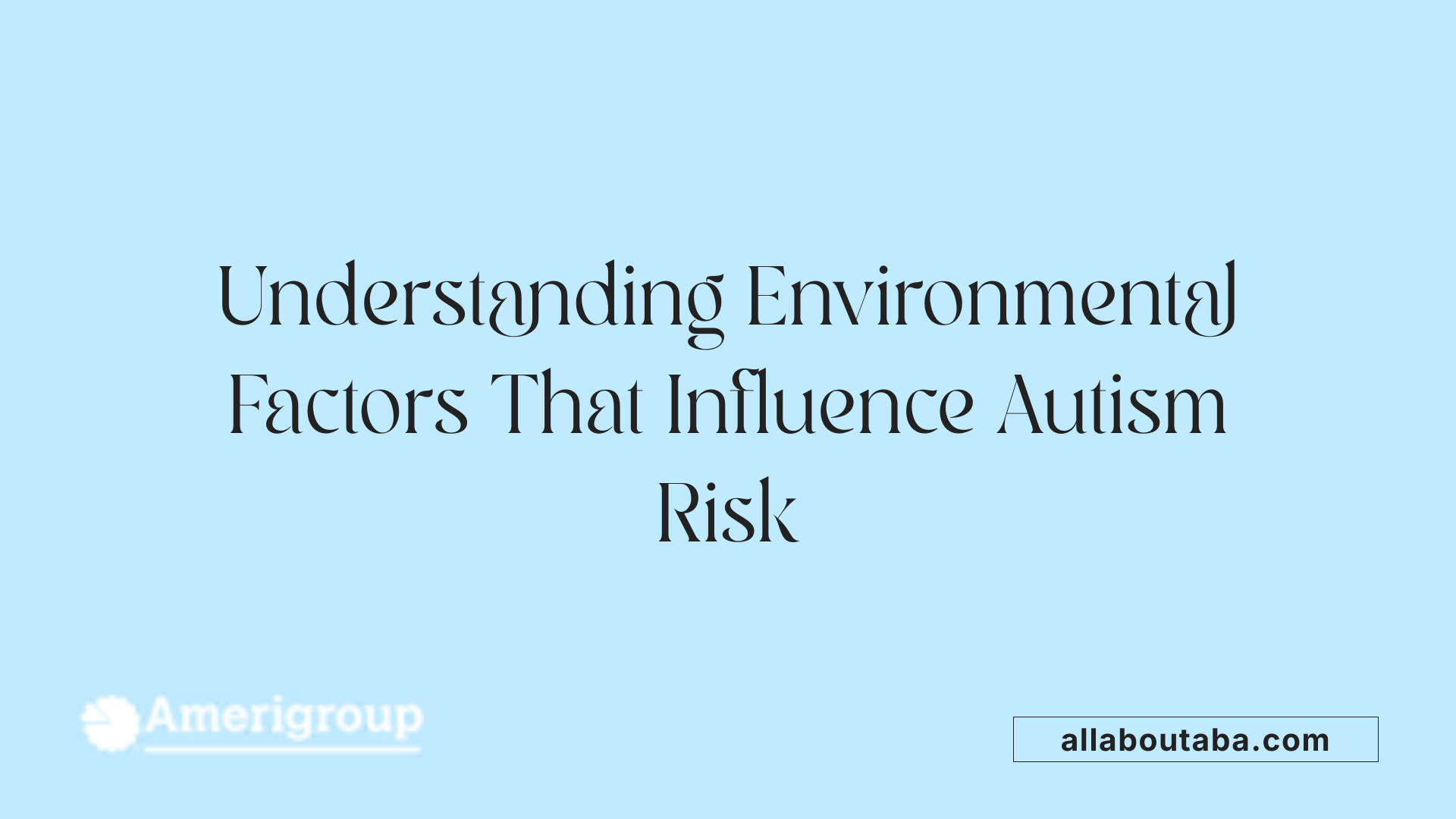
What are environmental factors and how do they influence autism?
Environmental factors encompass non-DNA influences impacting a child's early life stages — before, during, or after birth. These influences include exposure to pollutants, maternal health conditions, birth complications, parental age, and chemical agents.
Research indicates that certain environmental exposures are associated with increased autism risk. For example, pregnant women exposed to air pollution, pesticides, or heavy metals like mercury and lead may influence fetal neurodevelopment. Chemical compounds such as phthalates and flame retardants, prevalent in plastics and household products, are also under study.
Additionally, medical conditions and illnesses during pregnancy, like maternal infections, fever, diabetes, and obesity, contribute to the risk. Usage of specific medications such as valproic acid during pregnancy has been linked to higher autism odds.
Birth complications, including prematurity, low birth weight, or oxygen deprivation during delivery, are associated with a higher risk. Advanced parental age, especially paternal age over 34 or 40, has been repeatedly linked to increased autism prevalence, likely owing to increased de novo mutations.
Other factors like maternal mental health issues, stress, and nutritional deficiencies during pregnancy (e.g., low vitamin D or folic acid levels) may also influence neurodevelopment.
When does environmental exposure matter most?
The timing of environmental influence — preconception, prenatal, or postnatal — varied in research findings but clearly plays a role. Prenatal exposure to pollutants, maternal infection, and complications like preterm birth are critical factors. Exposure during these sensitive periods can alter gene expression, brain development pathways, and neural connectivity.
Postnatal influences such as infections, low birth weight, or complications like jaundice also pose risks, although they tend to act in conjunction with genetic predispositions.
How does the environment affect people with autism?
The environment significantly affects people with autism because many have sensory sensitivities that can cause distress, such as over- or under-sensitivity to light, sound, and other stimuli. Simple adjustments like reducing noise, dimming lights, providing quiet spaces, and offering sensory tools can help minimize sensory overload and improve comfort.
Clear communication through visual aids, maps, and advance information allows autistic individuals to navigate environments more easily and reduces anxiety. Creating autism-friendly environments also involves staff training, offering sensory-friendly times, and gathering feedback to continually improve accessibility.
Overall, tailored environmental modifications and tailored communication strategies support autistic people in having positive, inclusive experiences.
Biological Mechanisms Linking Environment and Autism
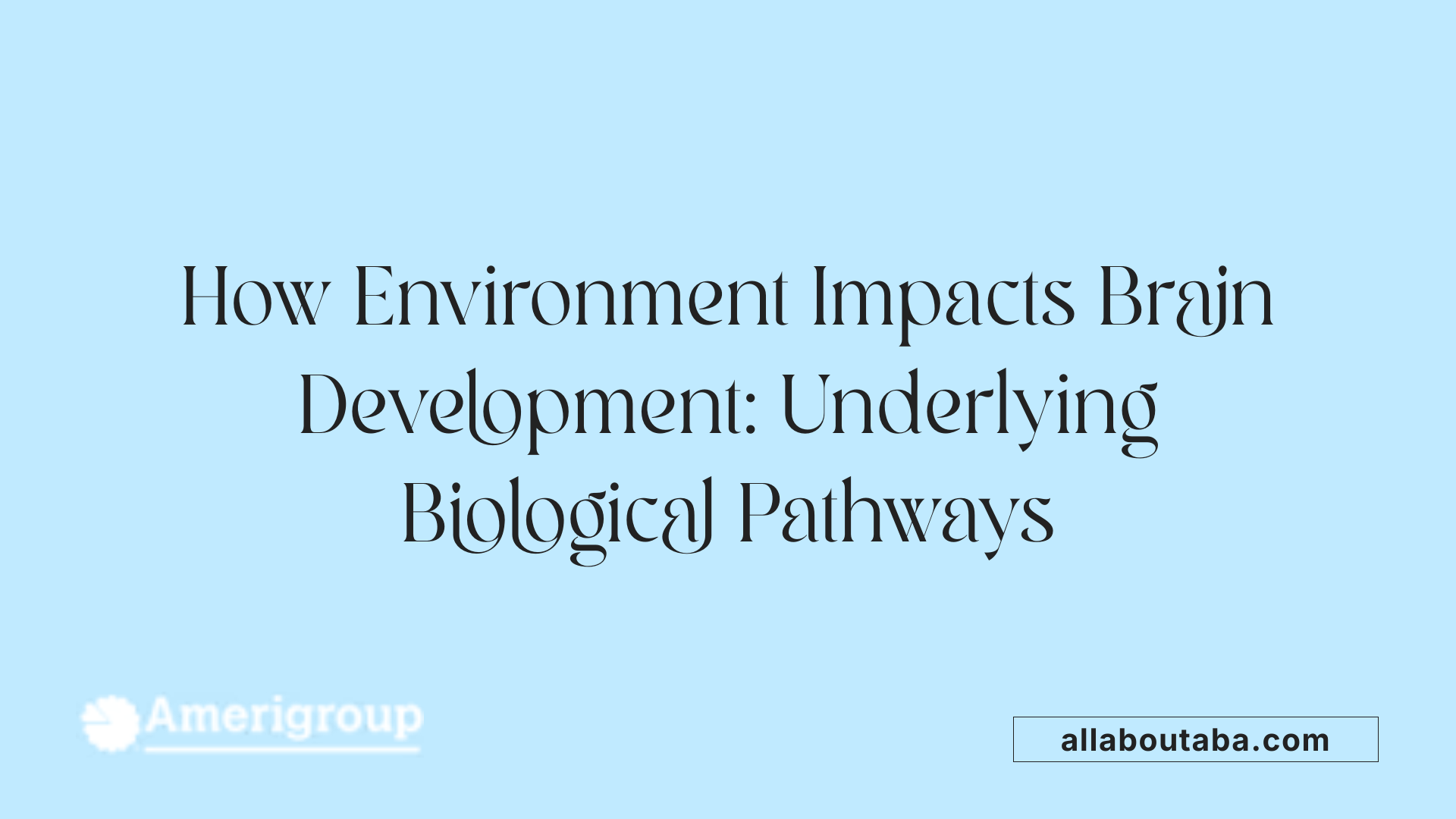
What are the biological mechanisms by which environmental exposures could contribute to autism?
Environmental influences can impact fetal brain development through various biological pathways. One prominent mechanism involves oxidative stress and inflammation. Pollutants such as heavy metals (like lead and mercury), pesticides, and industrial chemicals can generate reactive oxygen species, leading to oxidative DNA damage. This oxidative stress can impair normal neuronal growth and function, setting the stage for neurodevelopmental issues associated with autism.
Another crucial process is hypoxia or ischemia—conditions where the fetal brain experiences oxygen deprivation. Birth complications, maternal health issues, or exposure to environmental toxins may reduce oxygen supply, causing brain injury or disrupting neural circuitry development.
Epigenetic modifications are also significant mediators. Environmental toxins can alter gene expression without changing DNA sequences, primarily through DNA methylation and histone modification. Such epigenetic changes can silence or activate genes vital for neurodevelopment, thereby influencing autism risk.
Disruption of signaling pathways and hormonal balance further links environmental exposures to autism. Certain chemicals may interfere with endocrine signaling or neuronal growth signals during critical periods of brain maturation, leading to atypical neural connectivity.
Lastly, neurotransmitter systems and endocrine functions can be affected. Toxins and pollutants might dysregulate neurotransmitter levels—including serotonin, dopamine, and glutamate—or alter hormonal pathways, impacting brain structure and function.
Often, these environmental effects interact with genetic predispositions, amplifying risk. The result is a complex interplay where environmental exposures influence neurodevelopmental trajectories, potentially leading to autism spectrum disorder.
Genetic Mutations and Environmental Interactions
How might environmental factors contribute to genetic mutations related to autism?
Environmental influences can significantly impact genetic mutations linked to autism through various biological pathways. One of the primary mechanisms is epigenetic modification, where environmental factors such as pesticides, heavy metals, and pollutants cause changes in DNA methylation, histone modifications, and noncoding RNA activity. These changes do not alter the DNA sequence itself but can turn genes on or off, affecting neurodevelopment.
Exposure to harmful agents during pregnancy can induce direct DNA damage, leading to mutations if the damage is not properly repaired. Oxidative stress is a common consequence of environmental toxicants like lead, mercury, and pesticides. It results in reactive oxygen species (ROS) that modify bases, cause DNA crosslinks, and induce strand breaks, increasing mutation risk.
Another critical factor is the influence of parental age, especially paternal age. Older fathers have a higher likelihood of transmitting de novo mutations, which are new genetic alterations not inherited from either parent. These mutations often occur in sperm cells due to the continual cell divisions over time, raising the chance of errors during DNA copying.
Certain chemicals, known as mutagens, such as methylmercury, lead, and specific pesticides, have been documented to impair DNA repair pathways or cause direct damage to genetic material. This can facilitate the formation of mutations that disrupt genes involved in brain development.
Prenatal maternal health issues, including infection and exposure to teratogens like valproic acid, can also interfere with gene regulation during critical snapshots of brain development. These disruptions can promote genetic instability or epigenetic alterations, thereby influencing neurodevelopmental outcomes.
Research suggests that such environmental impacts may increase the mutation burden in genes associated with autism. When these mutations occur in genes regulating neural connectivity, synaptic function, or brain structure, they may elevate the risk of developing ASD.
In conclusion, environmental factors contribute to genetic mutations through the induction of DNA damage, epigenetic modifications, and by increasing the rate of de novo mutations, particularly in germ cells. Such alterations, especially during sensitive periods of neurodevelopment, can interact with genetic predispositions to influence autism susceptibility.
Key Environmental Risk Factors for Autism
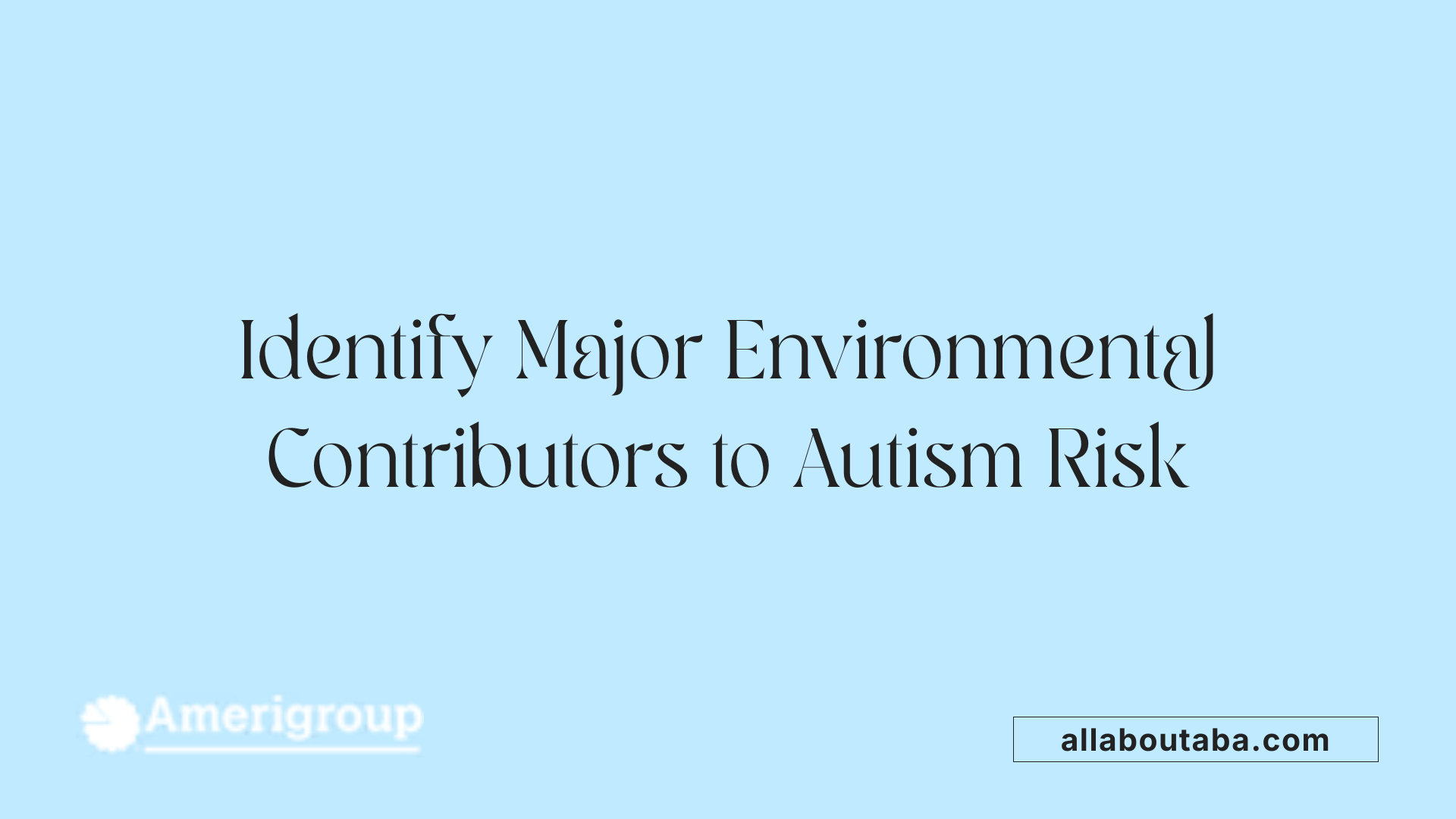
What are the main environmental risk factors associated with autism?
Research has identified several environmental influences that may increase the risk of autism spectrum disorder (ASD). While genetic factors play a significant role, environmental exposures during critical periods of development can also contribute.
One of the prominent areas of concern is exposure to air pollution, particularly traffic-related pollutants like nitrogen dioxide (NO2) and particulate matter (PM). Studies suggest that children prenatally exposed to higher levels of these pollutants are at increased risk of developing ASD. These pollutants can induce oxidative stress and DNA damage, which might interfere with normal neurodevelopment.
Pesticides and herbicides used during pregnancy have been linked to autism risk. Chemicals such as chlorpyrifos and other organophosphates can disrupt hormonal and neural pathways, especially if exposure occurs during vulnerable stages of fetal development.
Heavy metals like inorganic mercury, lead, and cadmium are well-studied environmental toxicants associated with neurodevelopmental issues, including autism. Mercury, especially in its inorganic form, can cause DNA damage and impair cellular functions in the brain, increasing the likelihood of neurodevelopmental disorders.
Maternal health issues—such as obesity, diabetes (particularly gestational diabetes), and immune system disorders—are also connected to higher ASD risk. These conditions often involve systemic inflammation and hormonal imbalances that can impact fetal brain development.
Birth complications including preterm birth, low birth weight, and oxygen deprivation during delivery (perinatal hypoxia) have strong associations with ASD. These factors can result in neurodevelopmental disruptions due to early brain injury or altered neural signaling.
Advanced parental age, particularly paternal age over 34 years, is consistently linked with increased autism risk. Older parental age is associated with a higher rate of de novo genetic mutations, which may contribute to the disorder.
The interaction between these environmental factors and genetic predisposition appears to be complex. Many small, cumulative influences can shape neurodevelopmental outcomes, emphasizing the need for comprehensive strategies aimed at minimizing risks.
Understanding these environmental contributors is vital in developing preventive measures. Strategies include reducing exposure to pollutants and toxic chemicals during pregnancy, promoting maternal health, managing birth complications, and considering parental age factors,
| Environmental Risk Factor | Description | Impact on Autism Risk |
|---|---|---|
| Air pollution (traffic pollutants) | Exposure to NO2 and particulate matter during pregnancy | Increased risk linked to oxidative stress and DNA damage |
| Pesticides/hazardous chemicals | Use during pregnancy, exposure to chlorpyrifos, etc. | Disruption of neural and hormonal pathways |
| Heavy metals (mercury, lead) | Environmental contamination, dietary intake | Induces genomic instability, neurotoxicity |
| Maternal health issues | Obesity, diabetes, immune disorders | Systemic inflammation affecting fetal brain development |
| Birth complications | Preterm birth, low birth weight, oxygen deprivation | Neurodevelopment disruptions due to early brain injury |
| Advanced parental age | Paternal age over 34 years | Increased mutation rate, de novo genetic alterations |
Studies continue to investigate how these environmental factors interact with genetic susceptibility. While no single factor causes autism alone, their cumulative effect can significantly influence development. Efforts to minimize exposure to harmful environmental agents, especially during pregnancy, are crucial steps in reducing ASD risk.
Childhood and Postnatal Environmental Risks
What postnatal factors are linked to increased autism susceptibility?
Research indicates that certain factors after birth can influence the likelihood of developing autism spectrum disorder (ASD). Jaundice, a common condition in newborns characterized by yellowing of the skin and eyes, has been associated with increased autism risk, especially when it leads to high levels of unconjugated bilirubin, which can be neurotoxic.
Infections such as meningitis, mumps, and varicella (chickenpox) have also been linked to a higher susceptibility to autism. These infections can cause inflammation in the brain or other neurodevelopmental disruptions that may brain development, particularly if they occur during critical windows of early childhood.
Low birth weight is another significant postnatal factor. Children born with very low weights (<1500 grams) or preterm (before 35 weeks) often face increased risks for autism. The vulnerability may result from underdeveloped organs, including the brain, and increased exposure to complications such as hypoxia (oxygen deprivation) which impair neural pathways.
Beyond these biological factors, early sensory processing challenges—such as heightened sensitivity to light, sound, or touch—may contribute to or signal underlying neurodevelopmental differences linked to autism. These sensory issues can affect social interaction and learning during critical periods.
Exposure to environmental toxins after birth, including heavy metals like lead and mercury or pollutants like air particulates, can also impact neurodevelopment. Such toxins may cause oxidative stress and inflammation, potentially interfering with neural growth and connectivity.
Another crucial aspect involves the impact of socio-economic status and access to healthcare. Children from lower socio-economic backgrounds often experience higher exposure to environmental pollutants, limited access to early intervention services, and nutritional deficiencies, all of which can exacerbate risks related to autism.
Early intervention and addressing postnatal environmental risks are vital for improving developmental outcomes. Managing health issues promptly, reducing exposure to environmental hazards, and ensuring adequate nutrition and support can mitigate some of the environmental influences affecting children vulnerable to ASD.
Current Scientific Understanding of Environmental Risk in Autism
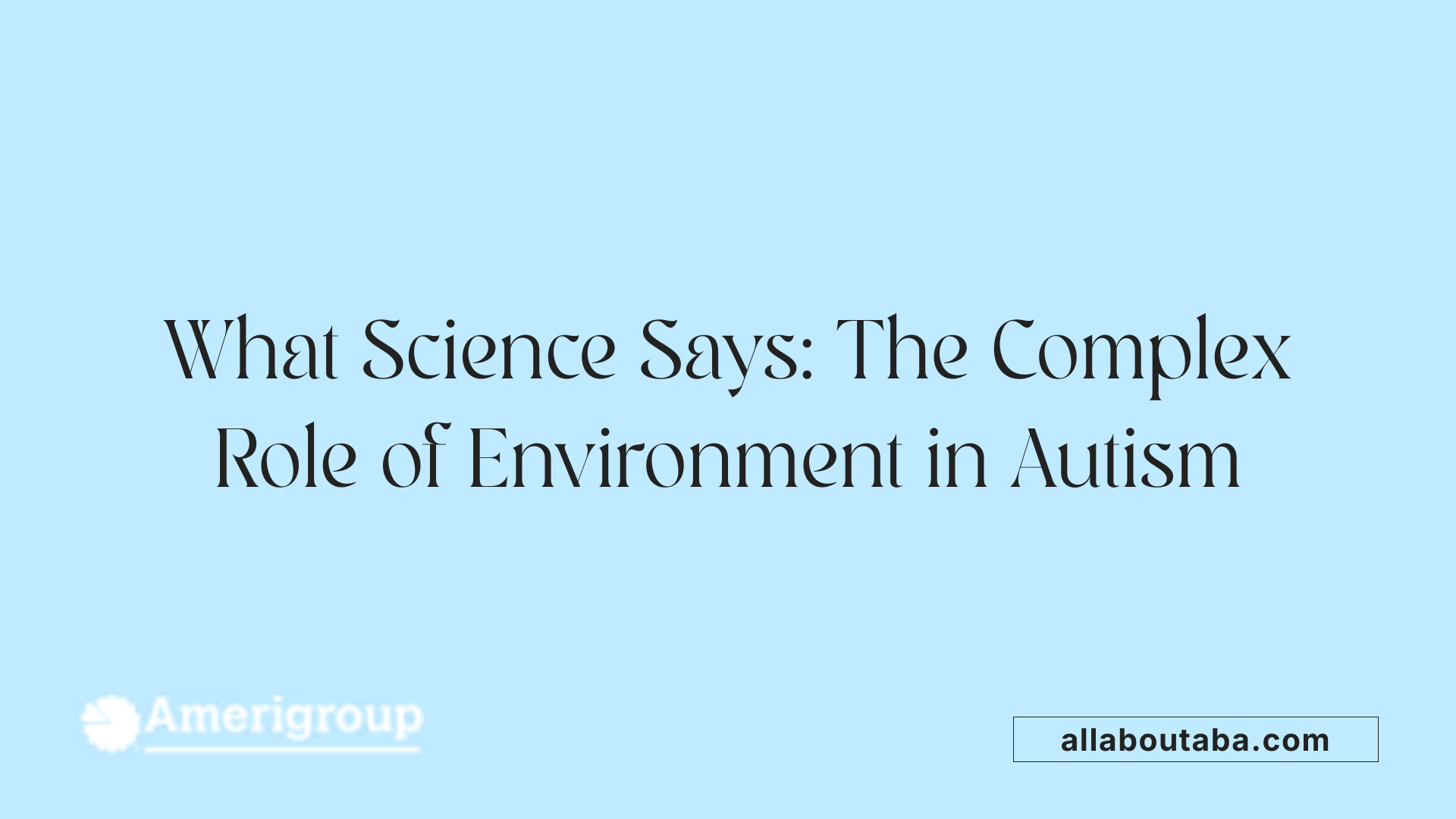
What does current scientific research say about environmental risk factors for autism?
Research to date indicates that environmental influences can play a significant role in the development of autism spectrum disorder (ASD). These factors, which are non-genetic, include exposures that may affect a child's neurodevelopment during pregnancy, birth, or early childhood. Studies highlight several prenatal risk factors such as advanced parental age, maternal health issues—including metabolic syndrome, diabetes, and infections—along with maternal immune activation and inflammation.
Environmental pollutants like pesticides, heavy metals (such as lead and inorganic mercury), air pollution, and chemicals such as phthalates and flame retardants have been associated with increased ASD risk. Birth complications, especially those involving oxygen deprivation and prematurity, also show a higher correlation with autism. Additionally, maternal medication use, particularly antiepileptic drugs like valproic acid, during pregnancy has been linked to heightened risk.
Although these environmental factors are associated with increased liability for autism—estimates suggesting they may explain up to 50% of variance—their effects are often small and interact with genetic factors. Genetic predispositions, which account for approximately 80% of ASD risk based on twin studies, combine with environmental exposures, influencing early brain development.
Importantly, extensive scientific research has consistently found no causal link between vaccines and autism, dispelling common misconceptions.
Overall, current studies portray autism as a condition emerging from complex gene-environment interactions rather than single causes. These findings emphasize that environmental exposures likely modulate risk in genetically susceptible individuals rather than directly causing autism.
Epidemiological data and statistical associations
Epidemiological research supports the association of several environmental factors with autism. For instance, data from large cohort studies like the Danish nationwide registry reveal that parental age, particularly advanced paternal age over 34 years, increases ASD risk, possibly due to higher rates of de novo mutations. Maternal health conditions such as obesity and diabetes are also linked to increased risk, possibly through inflammatory pathways.
Birth-related factors such as very low birth weight, prematurity, and neonatal complications have consistently shown links to autism. Environmental toxins, including air pollution and heavy metals, are associated with neurodevelopmental disruptions, supported by studies linking prenatal exposure to increased ASD prevalence.
Gene-environment interactions
Recent research emphasizes that genetic makeup influences how environmental factors impact ASD development. Hundreds of genes, many involved in neural connectivity and brain development, are associated with autism. Environmental exposures can cause epigenetic modifications or induce de novo mutations, especially in the context of genetic susceptibility.
For example, exposure to mutagenic chemicals can increase the rate of spontaneous genetic mutations, including de novo variants, which are significant contributors to autism—particularly in cases involving sibling recurrence and monozygotic twin studies.
Limitations of current studies
Despite the wealth of data, current research faces several limitations. Many studies are observational, making it difficult to establish causality. Confounding factors, such as socioeconomic status, genetic background, and co-occurring conditions, often complicate interpretations.
Furthermore, inconsistencies in measurements of exposures, timing, and doses, as well as variability in diagnostic criteria across studies, hinder definitive conclusions. The long latency and complex interplay of risk factors pose additional challenges in study design.
Research gaps and future directions
Future research aims to clarify mechanisms by which environmental factors influence neurodevelopment. Improved methodologies, such as high-throughput sequencing and biomarker analyses, can help identify specific genetic and epigenetic changes linked to environmental exposures.
Longitudinal studies with precise exposure assessments, larger sample sizes, and better control of confounding variables are crucial. Investigating gene-environment interactions at a molecular level will enhance understanding of autism’s etiology.
Research into potential preventive strategies, such as reducing exposure to known neurotoxicants during critical developmental periods, remains a vital focus. Additionally, exploring how maternal health and nutrition modulate risk provides avenues for early interventions.
Lack of causal proof but strong associations
It is important to note that, despite numerous associations, there is currently no definitive causal proof linking specific environmental factors to autism. Many exposures show correlation but are difficult to prove causative due to the multifactorial and complex nature of ASD.
Nonetheless, the consistency of certain associations and biological plausibility support a contributory role. For example, air pollutants and heavy metals can cause oxidative stress, inflammation, and genetic mutations, mechanisms that are biologically plausible in affecting neurodevelopment.
In conclusion, while environmental factors are strongly associated with autism, especially in genetically vulnerable individuals, they are not sole causes. The ongoing challenge is to unravel these complex interactions and translate findings into effective prevention and early intervention strategies.
Implications and Preventive Strategies
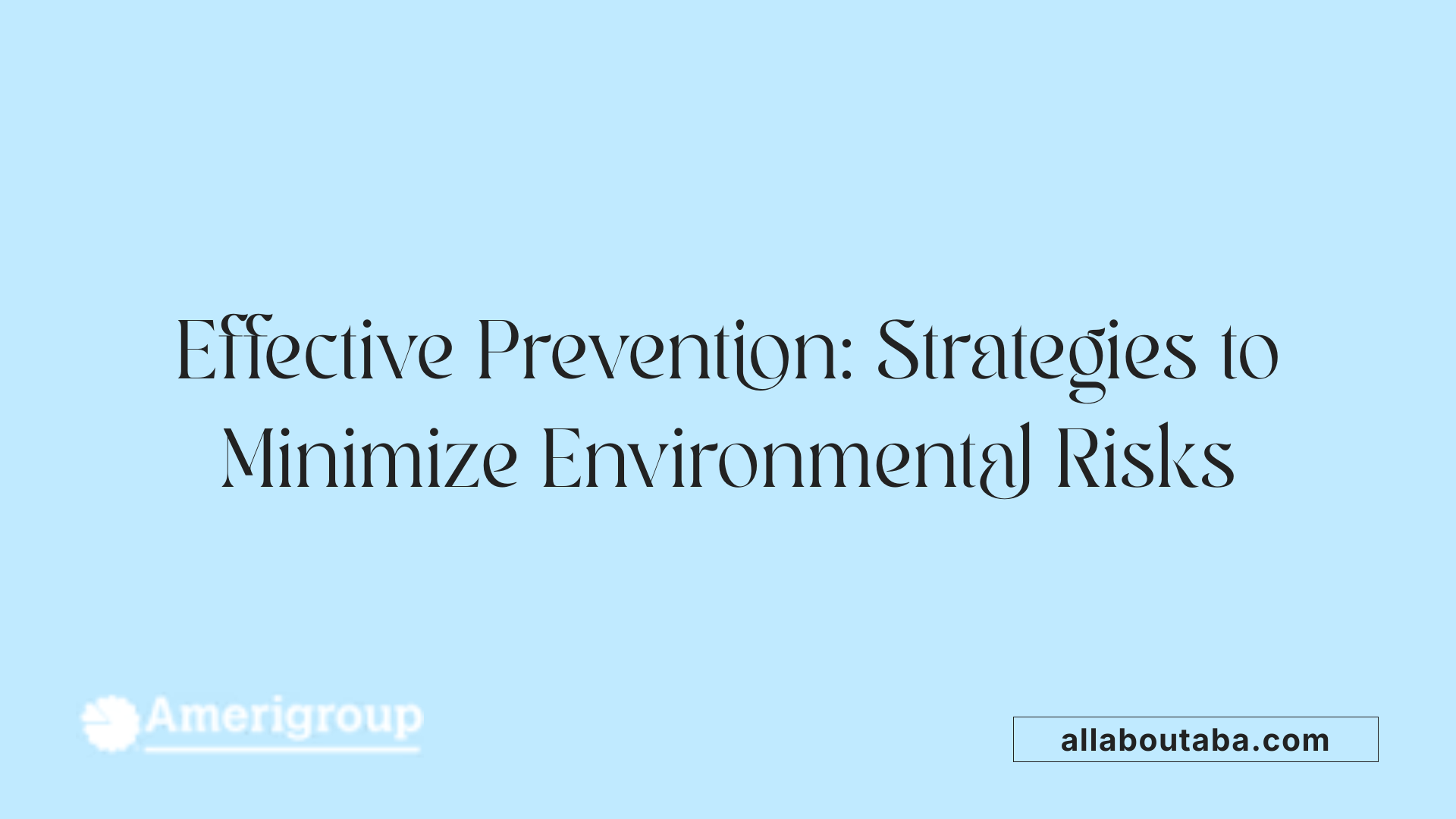
What are some preventive measures to reduce environmental risk factors for autism?
Preventive strategies aim to minimize harmful environmental exposures during critical periods of fetal and early childhood development. One of the most effective approaches is optimizing parental age at conception when possible, as advanced paternal and maternal ages are linked with increased autism risk due to higher likelihood of de novo genetic mutations.
Managing maternal health conditions is crucial. Conditions such as diabetes, obesity, and immune system disorders during pregnancy have been associated with higher autism susceptibility. Properly controlling these health issues through medical care and lifestyle changes can reduce potential risks.
Avoiding exposure to environmental pollutants is vital. This includes minimizing contact with pesticides, air pollution, heavy metals like mercury and lead, and endocrine-disrupting chemicals such as phthalates and bisphenol A. Advocacy for environmental policies that limit emissions of toxic substances and regulate hazardous chemicals can create safer environments for pregnant women and children.
Ensuring proper prenatal nutrition is imperative. Adequate intake of vitamins, especially vitamin D and folic acid, not only supports healthy fetal development but may also lower autism risk. Encouraging a balanced diet rich in omega-3 and omega-6 fatty acids can assist in neurodevelopment.
Avoiding certain medications during pregnancy, such as valproic acid and some antidepressants, under medical supervision is recommended, as they have been linked with increased autism risk. Healthcare providers should weigh the benefits and risks of prescribed drugs during pregnancy.
Public health initiatives should focus on education campaigns that highlight the importance of environmental health. Raising awareness about the impact of pollutants and the benefits of early screening and intervention can lead to timely support for at-risk children.
Personal lifestyle modifications for prospective parents also play a role. These include adopting a healthy diet, avoiding smoking and alcohol, and reducing exposure to household and environmental toxins.
Collectively, these measures aim to limit harmful exposures during key neurodevelopmental stages. While no single step guarantees prevention, combined efforts can decrease the overall risk of autism associated with environmental factors.
| Strategy | Actions | Expected Impact |
|---|---|---|
| Optimize parental age | Plan pregnancies at optimal ages within reproductive years | Reduce de novo mutations linked with advanced age |
| Manage maternal health | Control diabetes, obesity, and immune conditions during pregnancy | Lower inflammation and metabolic risks influencing ASD risk |
| Limit environmental pollutants | Minimize pesticide, heavy metal, and air pollution exposure | Decrease toxin-induced genomic and neurodevelopmental disruptions |
| Improve prenatal nutrition | Supplement with folic acid, vitamin D; consume omega-3s | Support healthy brain development; reduce deficiencies |
| Medication management | Avoid teratogenic drugs unless necessary, under supervision | Prevent drug-related neurodevelopmental risks |
| Public education | Campaigns on environmental health, early detection | Enhances awareness, early intervention opportunities |
Understanding and implementing these preventive strategies can contribute significantly to reducing environmental risks for autism. Future policies and individual choices together hold promise for fostering healthier neurodevelopmental outcomes.
Summary and Future Perspectives
What does current scientific research say about environmental risk factors for autism?
Current scientific research indicates that environmental risk factors for autism include prenatal, natal, and postnatal exposures that may influence neurodevelopment through epigenetic mechanisms. These factors do not independently cause autism but can increase the likelihood in genetically predisposed individuals.
Key factors identified are advanced parental age, especially paternal age over 34 years, which correlates with increased risk possibly due to higher rates of de novo mutations. Maternal health issues during pregnancy—such as metabolic syndrome (including diabetes and obesity), infections, fever, and immune activation—are also associated with higher autism risk in offspring.
Environmental pollutants like pesticides, heavy metals (including lead and inorganic mercury), and chemicals such as phthalates and bisphenol A have been studied for their potential impact on fetal brain development. Exposure to air pollution, especially traffic-related pollutants like nitrogen dioxide and particulate matter, during pregnancy and early childhood has emerging evidence linking it to increased ASD risk.
Birth complications, including premature birth, low birth weight, oxygen deprivation, and trauma during delivery, are strongly associated with autism. Moreover, maternal medication use during pregnancy, especially antiepileptic drugs such as valproic acid, has been linked to elevated risk.
Despite these associations, the overall contribution of environmental factors to autism liability is estimated to be between 17% and 50%. Genetic factors remain predominant, accounting for roughly 80% of risk, with hundreds of identified genes influencing neural development. The interaction between genetics and environment is complex, with many small factors working together.
Importantly, extensive research has definitively shown that vaccines, including MMR and thimerosal-containing vaccines, do not cause autism. This consensus is supported by numerous large-scale studies and systematic reviews.
Overall, current evidence underscores the multifactorial nature of autism, emphasizing both genetic predispositions and modifiable environmental influences that might affect early brain development.
Role of genetics and environment interplay
The understanding of autism etiology has evolved to recognize a significant interplay between genetic and environmental factors. While genetic influences are substantial—accounting for about 80% of the risk—environmental exposures can modulate this risk and may trigger or exacerbate underlying genetic susceptibilities.
Genetic factors involve inherited gene variants and spontaneous de novo mutations, which are non-inherited changes that occur in sperm, eggs, or early embryonic cells. Environmental factors such as parental age, exposure to toxins, and maternal health issues increase the likelihood of such mutations.
Environmental influences may cause epigenetic modifications—changes in gene expression without altering DNA sequences—that impact neural development. For example, exposure to pollutants can induce oxidative stress, inflammation, and hormonal disruption, all affecting brain development.
Twin studies support a significant gene-environment interaction, with monozygotic twins showing higher concordance rates for autism than dizygotic twins, but not complete overlap, indicating the role of environmental factors.
Understanding this interaction is crucial for developing preventive strategies and personalized interventions. It also highlights the importance of minimizing environmental risks during pregnancy and early childhood.
Importance of future research and policy
Future research should aim to clarify the biological mechanisms by which environmental exposures influence neurodevelopment, particularly gene-environment interactions. Improved study designs, larger cohorts, and longitudinal perspectives are essential to establish causality and identify critical periods of vulnerability.
Advancements in genomic technologies, such as whole-genome sequencing, help detect de novo mutations and somatic mosaicism, providing insights into mutation origins linked to environmental mutagens.
Policy-wise, focusing on reducing exposure to harmful pollutants, regulating chemicals, and promoting healthy maternal behaviors can mitigate risks. Prenatal care programs should include screening and guidance on avoiding environmental hazards and optimizing maternal health through nutrition and mental well-being.
Public health initiatives should emphasize awareness about the safety of vaccines and the dangers of exposure to toxins, dispelling myths and promoting evidence-based practices.
Collaborative efforts among scientists, policymakers, healthcare providers, and communities are vital to develop comprehensive approaches that reduce environmental risk factors, support early diagnosis, and improve outcomes for individuals with autism.
| Risk Factor | Description | Potential Mechanism |
|---|---|---|
| Advanced parental age | Parental age over 34 increases risk, especially paternal age | Increased de novo mutations in sperm |
| Maternal health issues | Diabetes, obesity, infections during pregnancy | Inflammation, epigenetic changes |
| Environmental pollutants | Pesticides, heavy metals, air pollution | Oxidative stress, endocrine disruption |
| Birth complications | Premature birth, low birth weight, oxygen deprivation | Brain development disruption |
| Medication use during pregnancy | Valproic acid, antidepressants | Teratogenic effects on neural development |
| Exposure to chemicals and toxins | Phthalates, BPA, vinyl chloride | Hormonal disruption, DNA damage |
Understanding these factors and their interactions will inform prevention efforts and foster a holistic approach to reducing autism risk, emphasizing both genetic understanding and environmental management.
Concluding Thoughts on Environmental Influences and Autism
Understanding the multifaceted environmental influences on autism spectrum disorder emphasizes the need for continued research, public health policies, and preventative strategies. While genetics remain a major contributor, environmental exposures—ranging from prenatal to postnatal periods—play a crucial role in shaping neurodevelopment. Addressing modifiable risk factors such as pollution, maternal health, and exposure to harmful chemicals is vital for reducing autism risk and supporting early intervention efforts. A collaborative effort involving scientists, policymakers, healthcare providers, and communities is essential to mitigate environmental hazards, foster awareness, and promote healthier developmental environments for future generations.
References
- What Role Does the Environment Play in Autism?
- Environmental risk factors for autism: an evidence-based review of ...
- Environmental factors influencing the risk of autism - PMC
- Autism Environmental Factors
- What causes autism? | Autism Speaks
- Environmental exposures associated with elevated risk for autism ...
- Autism spectrum disorder - Symptoms and causes - Mayo Clinic
- What causes autism? Genetic and environmental factors







